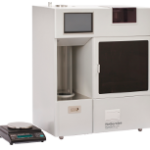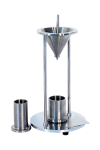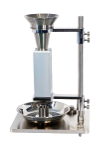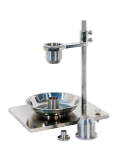Definition of parameters for the determination of macroscopic powder properties
Carr Angle of Repose
The angle of repose is the angle between a horizontal plane and the free surface of a conical powder pile (in static equilibrium) accumulated by powder falling from a defined height.
It is determined by the height (h) and the radius (r) of the conical powder pile:
Carr Angle of Repose = tan-1 (h/r)
Carr Angle of Fall or Carr Angle of Collapse
The angle of collapse corresponds to the angle of repose of a powder heap to which a defined impulse shock has been given.
Carr Angle of Difference
The angle of difference is the difference between angle of repose and the angle of collapse.
Carr Angle of Spatula or Flat-Plate-Angle
The flat-plate angle is the angle between the surface of a powder pile and a defined spatula on which it was piled up after burying the spatula under a powder bed and extracting it.
Carr Loose Bulk Density
The bulk density is determined from the volume and mass of a loosely packed powder.
Carr Packed Bulk Density or Tap Density
The tap density is determined by the volume and mass of the powder after it has been compressed, which is done through repeated dropping of a measuring cylinder from a defined height.
Carr Compressibility
The compressibility is calculated from the ratio of the difference between the bulk density (L) and tap density (P) to the determined tap density:
Carr Compressibility [%] = 100 (P – L)/P
Carr Cohesion
The cohesion is a measure for interparticular interactions and is determined by defined sieving of the powder sample (at a given sieving time).
Carr Uniformity
Uniformity is a measure for the width of the volume-based particle size distribution determined by sieving analysis.
Carr Uniformity = d60/d10
Carr Dispersibility
The dispersibility is determined by dropping 10.0 g of the powder to be characterized from a defined height into a bowl and subsequently determining the mass (m) of the powder remaining in the bowl.
Carr Dispersibility = 100 (10 g – m)/10 g
Voidage
The voidage or so called powder porosity indicates the percentage value of the interparticle volume to the total volume of the powder compacted to volume constancy.
Flowability index
The flowability index is calculated from the weighted sum of the angle of repose, flat-plate-angle, compressibility, cohesion and uniformity indices.
Floodability index
The floodability index is calculated from the weighted sum of the indices of the flowability index, the angle of collapse, the angle of difference and the dispersibility.
 Deutsch
Deutsch English
English




